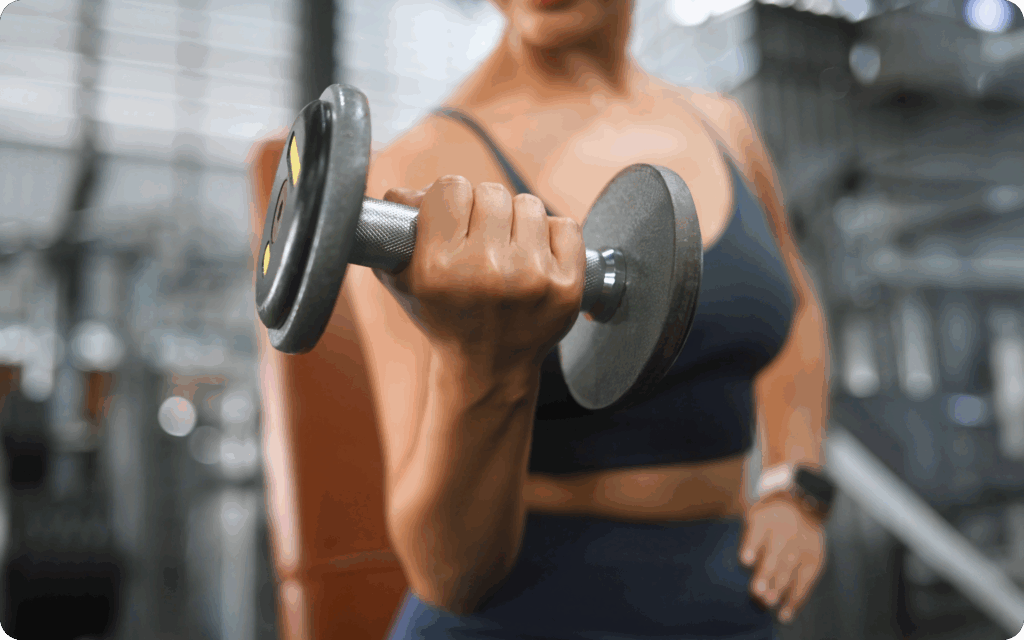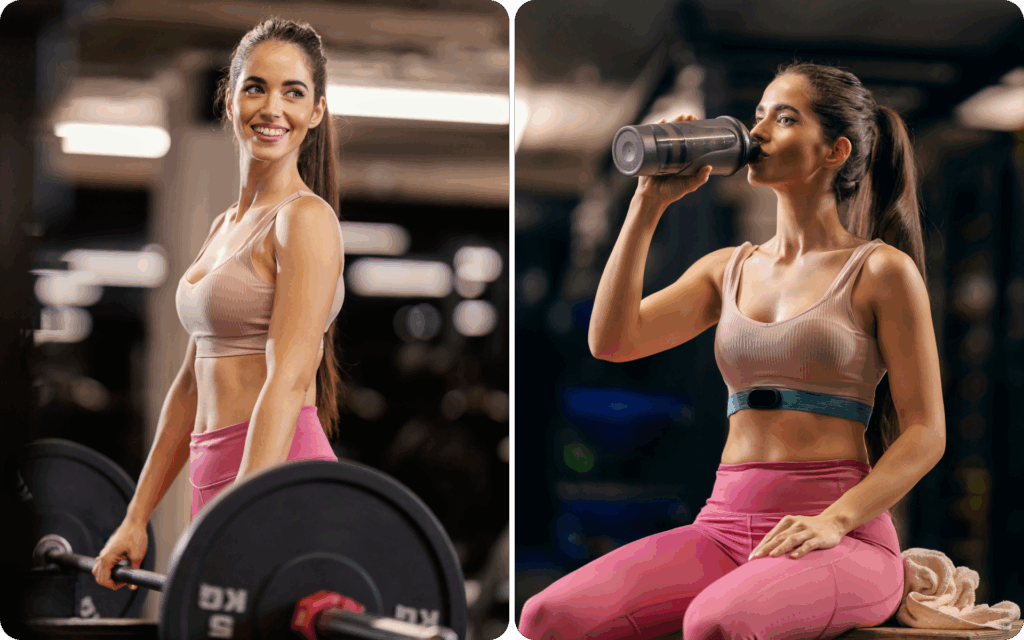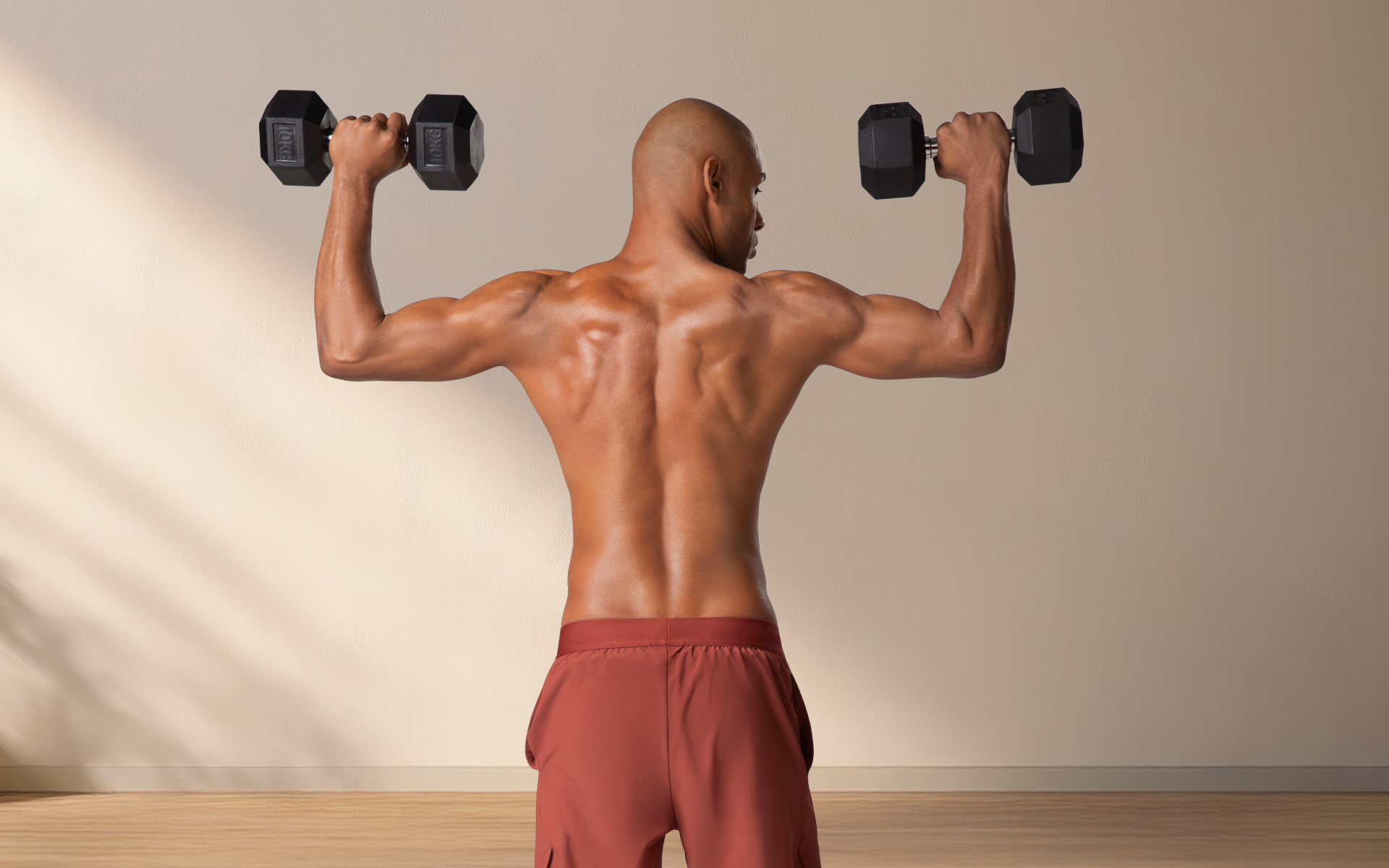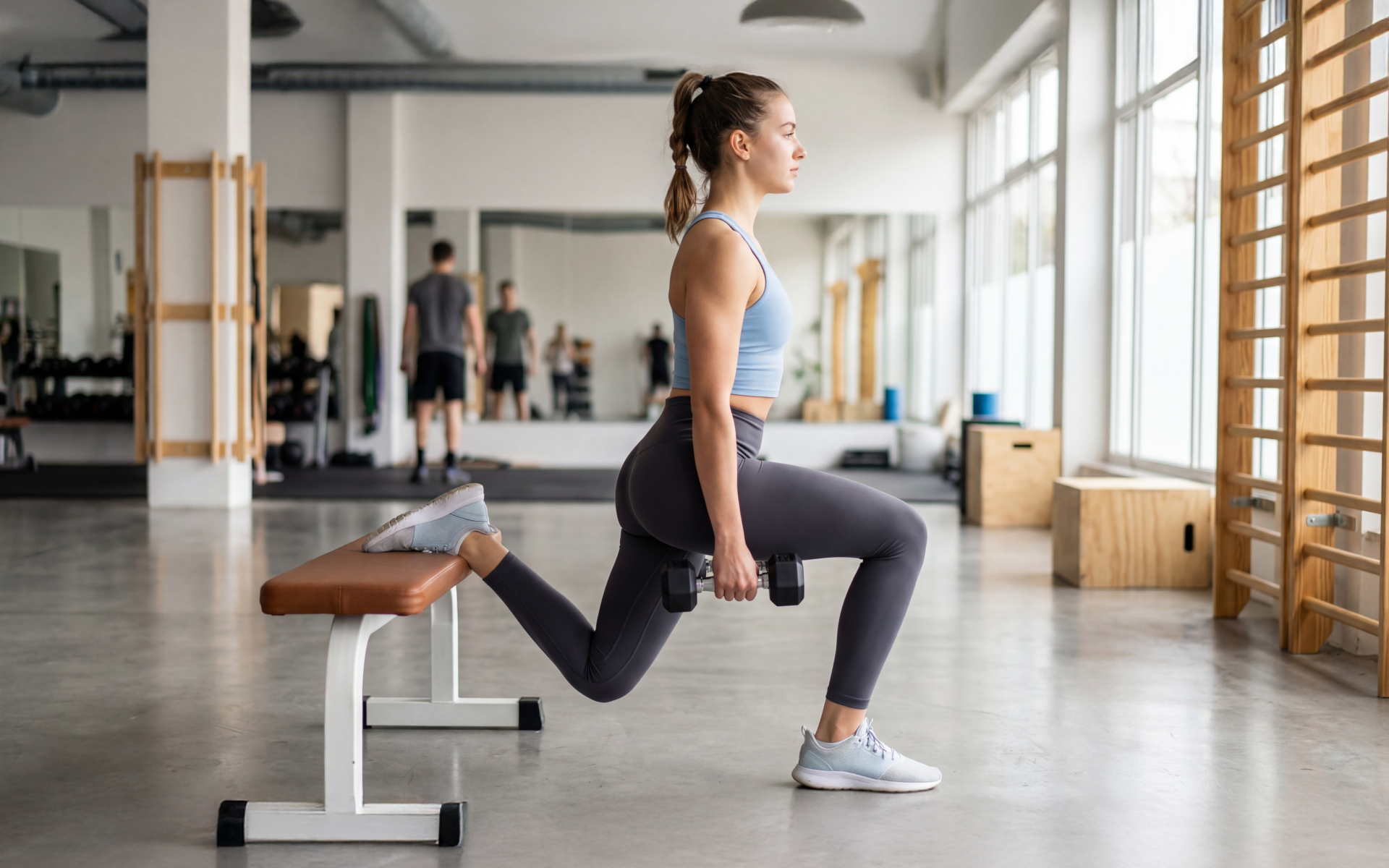If your goal is to simultaneously improve your strength, mobility, speed, and stamina, you don’t need multiple workout programs to do so – you can easily achieve this through a well-curated strength and conditioning workout plan.
Such a plan can help you lift heavier and even run faster and more efficiently, without having to be an athlete. But how do you structure a sustainable yet effective strength and conditioning program? Let’s find out!
What Is a Powerful Strength and Conditioning Workout Plan?
A powerful strength and conditioning workout plan is a structured training program that combines strength training, conditioning work, and mobility and recovery elements to build strength, improve endurance, enhance athletic performance, and support overall fitness.
In such a program, you’ll use:
- Strength training through heavy compound lifts to help you build muscle, increase power, and improve functional movement.
- Conditioning work through explosive cardio, circuit, or interval training to improve cardiovascular fitness and stamina/endurance.
- Mobility and recovery elements such as stretching and adequate rest days to keep your joints healthy and reduce injury risk from such an intensive routine
This type of routine will also use the practice of progressive overload (1) to help gradually and continuously push your body to do and achieve more.
Are you curious about circuit training for strength? Here’s an article with all the information you need for success.
How to Combine Strength and Conditioning
A program that combines strength and conditioning intentionally adds resistance and cardio work in a complementary manner. All the strength and conditioning exercises in the routine work together, which leads to better results.
You can do this through:
1. Resistance Circuit Training – This is an exercise program that combines resistance exercises (e.g. weightlifting, push-ups, squats) with aerobic exercises (e.g. jumping jacks, running, jump rope). The participant moves quickly (transitions) to each exercise “station” with little (e.g. 8 to 30 seconds) or no rest (2, 3).
2. Concurrent Training – This can happen in two ways:
-
- The person who is training can perform both endurance and resistance training exercises in a single training session.
- They can do endurance and resistance workouts on separate days, e.g. strength exercises on Monday, Wednesday, and Friday, and conditioning exercises on Tuesday and Thursday, leaving Saturday and Sunday for rest.
Concurrent training repeatedly subjects your muscles to different forms of physical demands and signals, which can help improve hypertrophy, strength, and power (4, 5, 6).
3. Hybrid Training – Research has described this as a new multicomponent exercise mode that activates the cardiovascular and the musculoskeletal system throughout the same exercise session. This is done at various intensities, using both muscle-strengthening exercises and dynamic cardiovascular activities (7).
It’s sometimes referred to as high-intensity functional training and has been shown to improve key physical attributes such as aerobic capacity, muscular strength, anaerobic power, and fatigue tolerance (8).
The best way to practice hybrid training in your strength and conditioning workout plan at home or the gym is to treat it as a HIIT workout, e.g. alternate between short bursts of all-out, maximum effort exercise (e.g. 20-45 seconds) with brief recovery periods (e.g. 10-30 seconds of rest or low-intensity movement).
Read more: Great Full-Body Workouts: The Ultimate Guide for Beginners
What Are the Main Benefits of Strength and Conditioning Workouts?
A program that integrates strength and conditioning exercises can help:
- Build muscle
- Boost metabolism, which enhances weight control
- Strengthen bones
- Improve heart health and enhance balance and mobility
- Improve athletic performance, particularly power and speed (9)
- Reduce injury risk
- Significantly improve mental well-being by reducing stress, anxiety, and improving mood and cognitive function
As previously mentioned, this routine combines heavy resistance training and explosive cardio/aerobic training.
By itself, resistance training is beneficial for improved physical performance, mobility, walking speed, functional independence, cognitive abilities, metabolic health, and self-esteem. It can also improve the chances of cancer survivorship and lower the risk of obesity and type 2 diabetes (10, 11).
On the other hand, studies on aerobic training have shown that it helps improve mental health and self-esteem, body mass, strength, mobility, and balance, regardless of age (12, 13, 14).
Check out these senior strength exercises to help improve health and muscular strength in older adults.
How to Plan a Strength and Conditioning Program
When you’re planning a strength and conditioning plan for beginners, you should:
- Incorporate S.M.A.R.T. goals – Your overall goals for the end of the program need to be specific, measurable, achievable, relevant, and timely.
- Assess your current fitness – This helps keep you from overdoing it or underexercising. Being truthful about your current fitness helps you create a balanced routine that pushes you to be better.
- Choose the right exercises – Heavy resistance training for strength and hypertrophy, and conditioning workouts for improving endurance. Always opt for compound lifts rather than isolation lifts. Always warm up and cool down before and after the workout. 5 to 10 minutes of each is enough per session.
- Progressive overload – Gradually increase the weight, reps, sets, or decrease rest time to keep challenging your body for better results. It also helps prevent exercise plateauing.
- Rest – All your efforts will be in vain if you don’t schedule and get enough rest weekly. 2 rest days a week are the minimum requirement for the best results. One day can be an active rest day, where you do light exercises or stretches such as yoga, and the other day should involve passive rest, where you can happily be a couch potato.
BetterMe: Health Coaching app helps you achieve your body goals with ease and efficiency by helping to choose proper meal plans and effective workouts. Start using our app and you will see good results in a short time.
What Is a Sustainable Strength and Conditioning Workout Plan?
A sustainable strength and conditioning plan should:
- Balance resistance, conditioning, and mobility movements that the user finds enjoyable.
- Incorporate gradual and consistent progressive overload, while allowing for ample recovery.
- Emphasize consistency over intensity, which can help propel the person exercising without burnout or overtraining.
- Be flexible, allowing for adaptations and variety to keep things fresh and match the exerciser’s lifestyle and needs.
Note that conditioning doesn’t always have to use weights to be effective. Bodyweight conditioning can still help you build strength, power, and flexibility without outside resistance.
Whether you’re a workout beast or just a beginner making your first foray into the world of fitness and dieting – BetterMe has a lot to offer to both newbies and experts! Install the app and experience the versatility first-hand!
How Many Reps for Strength and Conditioning?
Unfortunately, no single study has answered this question. However, the consensus in the fitness world states that, if your goal is:
- Maximum strength – 1-6 reps per set with heavy weights
- Hypertrophy – 6-12 reps per set
- Endurance – 15+ reps per set using lighter weights/load
Read more: Workouts for the Week: All Your Biggest Questions Answered
What Is the Best Split for Strength and Conditioning?
Beginners are recommended to do full-body splits (two days a week for strength training), while intermediate and advanced exercisers can choose between an upper/lower split (4 days/week) and push/pull/legs (PPL) (3-6 days/week), depending on their preferences. All exercisers shouldn’t ignore their cardio and must practice progressive overload.
Yes, four exercises can be enough for a workout, particularly if you do compound movements that target all major muscle groups in one session. Yes, it is. As mentioned above, 6-12 reps are the recommended number for muscle hypertrophy. Therefore, 4 sets of 10 reps can help you achieve this goal. As with noticeable weight loss, the results may vary. However, it generally takes between 6 and 12 weeks to see noticeable muscle growth. Yes, low reps with heavier weights are considered to be better for increased muscle strength.Frequently Asked Questions
Is four exercises enough for a workout?
Is 4 sets of 10 enough to build muscle?
How long does it take to see muscle growth?
Are low reps better for strength?
The Bottom Line
A strength and conditioning workout plan can help you reach your goals, but only if it’s well-curated and sustainable. To see the best results, you should choose a routine that matches your fitness level, balances resistance training, cardio, and mobility exercises, and incorporates progressive overload, in addition to getting ample rest and improving your diet to help supplement the workout routine.
DISCLAIMER:
This article is intended for general informational purposes only and does not serve to address individual circumstances. It is not a substitute for professional advice or help and should not be relied on for making any kind of decision-making. Any action taken as a direct or indirect result of the information in this article is entirely at your own risk and is your sole responsibility.
BetterMe, its content staff, and its medical advisors accept no responsibility for inaccuracies, errors, misstatements, inconsistencies, or omissions and specifically disclaim any liability, loss or risk, personal, professional or otherwise, which may be incurred as a consequence, directly or indirectly, of the use and/or application of any content.
You should always seek the advice of your physician or other qualified health provider with any questions you may have regarding a medical condition or your specific situation. Never disregard professional medical advice or delay seeking it because of BetterMe content. If you suspect or think you may have a medical emergency, call your doctor.
SOURCES:
- Progressive overload without progressing load? The effects of load or repetition progression on muscular adaptations (2022, pmc.ncbi.nlm.nih.gov)
- Effect of resistance circuit training on comprehensive health indicators in older adults: a systematic review and meta-analysis (2024, nature.com)
- Circuit Training (n.d., sciencedirect.com)
- Concurrent Training A Meta-Analysis Examining Interference of Aerobic and Resistance Exercises (2012, journals.lww.com)
- Concurrent exercise training: do opposites distract? (2016, pmc.ncbi.nlm.nih.gov)
- Concurrent Training for Sports Performance: The Two Sides of the Medal (2018, researchgate.net)
- Hybrid Neuromuscular Training Improves Cardiometabolic Health and Alters Redox Status in Inactive Overweight and Obese Women: A Randomized Controlled Trial (2021,
- High Intensity Functional Training in Hybrid Competitions: A Scoping Review of Performance Models and Physiological Adaptations (2025, mdpi.com)
- The Role of High-Intensity Interval Training (HIIT) in Neuromuscular Adaptations: Implications for Strength and Power Development—A Review (2025, pmc.ncbi.nlm.nih.gov)
- Resistance training is medicine: effects of strength training on health (2012, pubmed.ncbi.nlm.nih.gov)
- The Health Benefits of Resistance Exercise: Beyond Hypertrophy and Big Weights (2023, journals.lww.com)
- Effect of aerobic training versus resistance training for improving cardiorespiratory fitness and body composition in middle-aged to older adults: A systematic review and meta-analysis of randomized controlled trials (2024, sciencedirect.com)
- Aerobic Exercise Combination Intervention to Improve Physical Performance Among the Elderly: A Systematic Review (2021, frontiersin.org)
- The effects of aerobic exercise training on mental health and self-esteem of type 2 diabetes mellitus patients (2019, pmc.ncbi.nlm.nih.gov)











